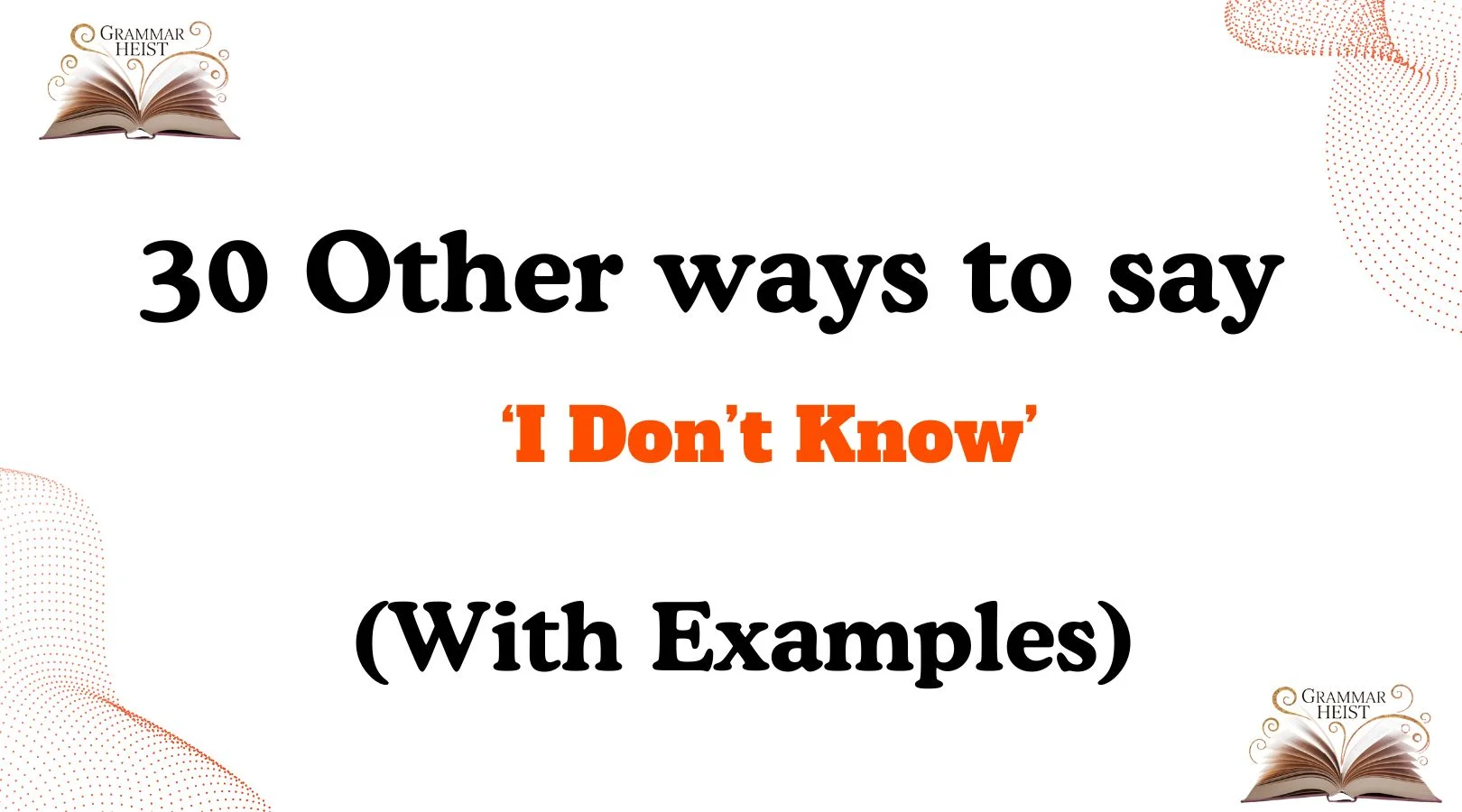Sometimes, how we say something matters just as much as what we say. When you simply respond with “I don’t know,” it can sound a little blunt, uncertain, or even distant. But with a few warm and thoughtful alternatives, you can turn uncertainty into connection — showing that you care, are open to learning, or are willing to help find the answer. Whether in a professional conversation, a casual chat, or an emotional moment, using kind and intentional language can make your message more meaningful and clear.
What Does “I Don’t Know” Mean?
The phrase “I don’t know” is a simple way to say you don’t have the information or answer at the moment. It can express uncertainty, honesty, or the need for more time to respond. While it’s a valid response, how you phrase it can impact how others receive it.
- Direct meaning: Admitting lack of knowledge.
- Emotional impact: Can feel dismissive or uncertain if not softened.
- Better alternatives: Show willingness to help, curiosity, or empathy.
Is It Professional/Polite to Say “I Don’t Know”?
Yes, it can be polite if said with care. But in professional settings, a more constructive alternative often works better. For example:
- “I’m not sure right now, but I’ll find out.” feels more helpful.
- “That’s a good question — let me check on it.” sounds collaborative.
👉 A gentle and proactive tone can transform a simple “I don’t know” into a moment of trust and teamwork.
Pros or Cons of Saying “I Don’t Know”
Pros:
- Shows honesty and authenticity.
- Builds trust when followed by action.
- Encourages open communication.
Cons:
- May sound careless if left as a standalone answer.
- Can create awkward silence or uncertainty.
- Might seem unhelpful in professional settings.
✅ The key is not to avoid “I don’t know” but to say it better.
Synonyms For “I Don’t Know”
- I’m not sure
- That’s a good question
- I’ll find out
- Let me check on that
- I’ll look into it
- I don’t have that information right now
- I’m not the best person to answer that
- That’s outside my expertise
- I’ll need to think about that
- I can’t say for sure
- I’ll get back to you on that
- Let me think about it
- I’ll check with someone who knows
- I’m learning about that
- I might be wrong, but…
- Let’s find out together
- I haven’t figured that out yet
- That’s something I need to look into
- I don’t have an answer for that yet
- That’s not clear to me
- I can’t give a definite answer
- I don’t have enough information yet
- I need to double-check
- I can find out if you’d like
- I’ll need some time to figure it out
- I’m working on understanding that
- That’s something I’ll learn
- I’m not 100% sure
- I can’t give you a straight answer right now
- I’ll let you know when I do
1. “I’m not sure.”
Scenario: When someone asks you a question and you honestly don’t have a clear answer.
Examples:
- “I’m not sure, but I can find out for you.”
- “I’m not sure at the moment — let’s figure it out together.”
- “I’m not sure, but I’ll check and get back to you.”
Tone: Friendly, honest, gentle.
Explanation: This sounds open and approachable without shutting the conversation down.
2. “That’s a good question.”
Scenario: When someone asks something thoughtful or unexpected.
Examples:
- “That’s a good question — I’ll need to think about it.”
- “That’s a good question. I’m not entirely certain.”
- “That’s a good question, and I’ll try to find the best answer.”
Tone: Curious, respectful.
Explanation: This alternative acknowledges the other person’s input and buys you time.
3. “I’ll find out.”
Scenario: In a work or team situation where you can look up or ask for the answer.
Examples:
- “I’ll find out and let you know soon.”
- “I’ll find out and circle back with you.”
- “I’ll find out right away.”
Tone: Proactive, responsible.
Explanation: This turns a moment of not knowing into an action plan.
4. “Let me check on that.”
Scenario: When information is available but not at your fingertips.
Examples:
- “Let me check on that and get back to you.”
- “Let me check and confirm before I answer.”
- “Let me check on that first.”
Tone: Helpful, composed.
Explanation: Shows you’re taking initiative, not avoiding the question.
5. “I’ll look into it.”
Scenario: When the topic needs a bit of research or follow-up.
Examples:
- “I’ll look into it and update you.”
- “I’ll look into it before giving a definite answer.”
- “I’ll look into it and share what I find.”
Tone: Reliable, professional.
Explanation: Great for professional settings where commitment matters.
6. “I don’t have that information right now.”
Scenario: When the answer exists but you don’t have it in the moment.
Examples:
- “I don’t have that information right now, but I can check.”
- “I don’t have that right now, but I’ll find out.”
- “I don’t have the details yet, but I’ll update you.”
Tone: Calm, clear.
Explanation: Communicates transparency and readiness to help.
7. “I’m not the best person to answer that.”
Scenario: When the topic isn’t in your area of expertise.
Examples:
- “I’m not the best person to answer that, but I can connect you to someone who is.”
- “I might not have the full answer, but I can guide you to the right source.”
- “I’m not the best person for that question, but I’ll help you find who is.”
Tone: Honest, cooperative.
Explanation: Shows humility and helpfulness.
8. “That’s outside my expertise.”
Scenario: When someone asks a specialized or technical question.
Examples:
- “That’s outside my expertise, but I can ask someone knowledgeable.”
- “That’s outside my expertise, but I can try to help.”
- “That’s outside my expertise — let me find someone who knows.”
Tone: Respectful, professional.
Explanation: Protects your credibility while being resourceful.
9. “I’ll need to think about that.”
Scenario: When you need time to give a thoughtful response.
Examples:
- “I’ll need to think about that before answering.”
- “I’ll need to give that some thought.”
- “I’ll need a little time to think it through.”
Tone: Reflective, thoughtful.
Explanation: Shows you value accuracy and clarity.
10. “I can’t say for sure.”
Scenario: When you’re unsure about accuracy.
Examples:
- “I can’t say for sure, but I can look into it.”
- “I can’t say for sure at the moment.”
- “I can’t say for sure, but I’ll double-check.”
Tone: Honest, neutral.
Explanation: Keeps communication clear without overpromising.
11. “I’ll get back to you on that.”
Scenario: When you plan to respond later with the correct info.
Examples:
- “I’ll get back to you on that tomorrow.”
- “I’ll get back to you with the details.”
- “I’ll get back to you once I confirm.”
Tone: Responsible, reassuring.
Explanation: Great for business or formal communication.
12. “Let me think about it.”
Scenario: When you need a pause to reflect.
Examples:
- “Let me think about it for a moment.”
- “Let me think about it before I answer.”
- “Let me think about it and get back to you.”
Tone: Calm, composed.
Explanation: A warm and natural response in both casual and serious conversations.
13. “I’ll check with someone who knows.”
Scenario: When someone else has the answer.
Examples:
- “I’ll check with someone who knows more.”
- “I’ll check with the team and update you.”
- “I’ll check with them and let you know.”
Tone: Supportive, helpful.
Explanation: Shows teamwork and willingness to find solutions.
14. “I’m learning about that.”
Scenario: When the topic is new to you.
Examples:
- “I’m learning about that, so I don’t have a full answer yet.”
- “I’m still learning about it, but I can find more.”
- “I’m learning — let me update you once I know more.”
Tone: Humble, open-minded.
Explanation: Normalizes not knowing and shows growth mindset.
15. “I might be wrong, but…”
Scenario: When you’re unsure but willing to offer a guess.
Examples:
- “I might be wrong, but I think it’s tomorrow.”
- “I might be wrong, but that’s how I understood it.”
- “I might be wrong, but I believe that’s the process.”
Tone: Cautious, respectful.
Explanation: Keeps communication honest and flexible.
16. “Let’s find out together.”
Scenario: When you want to collaborate on finding the answer.
Examples:
- “Let’s find out together — I’m curious too.”
- “Let’s check it out together.”
- “Let’s find the answer as a team.”
Tone: Warm, inclusive.
Explanation: Strengthens teamwork and shared curiosity.
Read More:30 Other Ways to Say ‘In Conclusion’ (With Examples)
17. “I haven’t figured that out yet.”
Scenario: When you’re still exploring or learning.
Examples:
- “I haven’t figured that out yet, but I will.”
- “I haven’t figured that out yet — still working on it.”
- “I haven’t figured that out yet, but I’ll let you know.”
Tone: Honest, humble.
Explanation: Communicates work-in-progress without pressure.
18. “That’s something I need to look into.”
Scenario: When the topic requires checking or research.
Examples:
- “That’s something I need to look into more.”
- “That’s something I need to look into before I answer.”
- “That’s something I need to look into first.”
Tone: Professional, careful.
Explanation: Ideal in serious or formal discussions.
19. “I don’t have an answer for that yet.”
Scenario: When you simply don’t have an answer right now.
Examples:
- “I don’t have an answer for that yet, but I will soon.”
- “I don’t have an answer yet, but I’ll check.”
- “I don’t have an answer yet — give me some time.”
Tone: Honest, steady.
Explanation: Straightforward but gentle and clear.
20. “That’s not clear to me.”
Scenario: When the topic itself is unclear.
Examples:
- “That’s not clear to me yet.”
- “That’s not clear to me, but I’ll clarify it.”
- “That’s not clear to me right now.”
Tone: Calm, transparent.
Explanation: Shows you’re not guessing but seeking clarity.
21. “I can’t give a definite answer.”
Scenario: When you don’t want to mislead.
Examples:
- “I can’t give a definite answer right now.”
- “I can’t give a definite answer, but I’ll confirm.”
- “I can’t give a definite answer at this point.”
Tone: Serious, composed.
Explanation: Perfect for important or sensitive matters.
22. “I don’t have enough information yet.”
Scenario: When the question requires more data.
Examples:
- “I don’t have enough information yet to say for sure.”
- “I don’t have enough information yet, but I’ll gather it.”
- “I don’t have enough info to answer confidently.”
Tone: Thoughtful, measured.
Explanation: Shows professionalism and responsibility.
23. “I need to double-check.”
Scenario: When you want to verify before responding.
Examples:
- “I need to double-check before answering.”
- “I need to double-check to be sure.”
- “I need to double-check that information.”
Tone: Responsible, accurate.
Explanation: Signals accuracy matters to you.
24. “I can find out if you’d like.”
Scenario: When offering help to find the answer.
Examples:
- “I can find out if you’d like.”
- “I can find out and let you know shortly.”
- “I can find out for you.”
Tone: Polite, helpful.
Explanation: Shows initiative and kindness.
25. “I’ll need some time to figure it out.”
Scenario: When solving a complex issue.
Examples:
- “I’ll need some time to figure it out.”
- “I’ll need some time to work on that.”
- “I’ll need a bit of time to sort it out.”
Tone: Honest, calm.
Explanation: Shows care and patience.
26. “I’m working on understanding that.”
Scenario: When still processing or learning.
Examples:
- “I’m working on understanding that better.”
- “I’m still trying to understand it.”
- “I’m working on it right now.”
Tone: Open, humble.
Explanation: Encourages patience and empathy.
27. “That’s something I’ll learn.”
Scenario: When committed to learning.
Examples:
- “That’s something I’ll learn soon.”
- “That’s something I’ll learn and share with you.”
- “That’s something I’ll learn over time.”
Tone: Growth-oriented, positive.
Explanation: Emphasizes willingness to improve.
28. “I’m not 100% sure.”
Scenario: When you’re partially but not fully certain.
Examples:
- “I’m not 100% sure, but I can confirm.”
- “I’m not 100% sure, but I think so.”
- “I’m not 100% sure right now.”
Tone: Honest, polite.
Explanation: Keeps things transparent and flexible.
29. “I can’t give you a straight answer right now.”
Scenario: When the situation is unclear or in progress.
Examples:
- “I can’t give you a straight answer right now, but I’ll update you.”
- “I can’t give you a straight answer at this moment.”
- “I can’t give you a straight answer — it’s still developing.”
Tone: Serious, respectful.
Explanation: Useful in sensitive or uncertain conversations.
30. “I’ll let you know when I do.”
Scenario: When you plan to follow up later.
Examples:
- “I’ll let you know when I do.”
- “I’ll let you know once I have more clarity.”
- “I’ll let you know as soon as I find out.”
Tone: Warm, reassuring.
Explanation: Leaves the conversation open and connected.
📝 Conclusion
Not knowing something isn’t a weakness — it’s an opportunity to connect, learn, or build trust. A simple “I don’t know” can feel blunt, but a thoughtful alternative shows honesty, care, and intention. Whether it’s at work, in a personal chat, or a casual moment, your words can shape the tone of the conversation.

Mia Rose is a skilled language expert with a deep passion for helping individuals master the art of writing and communication. With years of experience in the field, Marie brings a thoughtful and tailored approach to grammar, style, and language improvement. Her goal is to empower others to express themselves with clarity, precision, and confidence in every written word.













